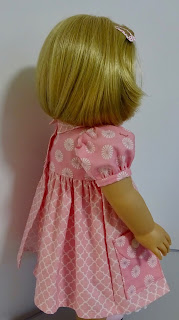While making the school uniform dress I perfected a lot of my skills in making dresses.
If you have the Uniform Pattern No.1 It is worth reading through this post to get a better feel for why I have done things a certain way.
If you have the 1804 or 2004 Dress Pattern you should also have a read because you may be able to improve how you sew the dresses by applying some of the points. You should try adding an extra 1/4" to the back facings. One day I will redo the pattern pieces but not for a while yet.
There are some slight variations to the way I used to make dresses that I think make it easier to get a perfect result.
I will point out the things I did differently for the school dress and explain why I did them that way.
- I made the back facing 3/4". I did this so you can finish the raw back edge with a single fold hem or a rolled hem or overlocking while cutting off 1/8"
- I pressed the back facing fold line before finishing the back edge so you can just measure 3/4" and fold and press. If you do it after neatening the back edge you would have to check where the fold line was by using the pattern piece.
- When stitching the collar pieces together use a short 2mm stitch. This makes it easier to go round the curves and also helps to stop the corner poking out and breaking through the stitches while you are pushing out the corner.
- I placed and basted each collar 1 at a time. In the past I just pinned them on and basted right across. I also place the doll's left collar on first so the other collar lies on top at the CF. This makes it easier to sew across the front when you sew on the collar.
- The collars have to be at lest 1/4" from the facing fold line so you can overlap the backs to close.
- When I stitch on the collar I am happy with stitching the seam then overlocking it. Press it then under stitch on the right side 1/8" away from the seam line, keeping the collar out of the way.
- For the School dress I have added a bias facing to the neckline. I experimented with a 1" wide piece folded in half then I experimented with a 1 1/8" bias piece folded in half. Even though the narrower facing only just covers the trimmed seam it works best. When stitching it down you aim along the middle of the strip so you are close to the seam line and it all turns out good.
If you use the wider strip you end up with a fraction too much facing width so you have a choice of stitching close to the neck seam line and having a flappy facing edge or sewing close to the facing edge and having trouble getting the neck to sit flat. - I made the bias facing strip about an inch too long because there is nothing worse than finding you are just a fraction short with strips. This means that if you find that your are just a fraction short on fabric for the bias strip you can cut it back about 3/4" shorter and it should still work. I don't recommend doing this unless you have tried the design with the full strip at least once to calculate for yourself how much shorter you can make it.
- I am still not set in one way to do the hem and fold the back facings in. Sometimes I overlock the hem the fold in the back facing and stitch across the facing on the hemline. You then turn the back facing and stitch the hem. I do it this way in some of my instructions.
- Another way it to overlock the hem leaving thread tails at each end. Press up the hem tucking in the thread tails then fold in the back facing and stitch the hem and back facing at the same time. I do it this way in some of my instructions.
- A third way to do the hem is to overlock the hem leaving thread tails. Press up the hem tucking the tails in. Stitch the hem then turn in the back facing.
Happy Sewing,
Val



















































